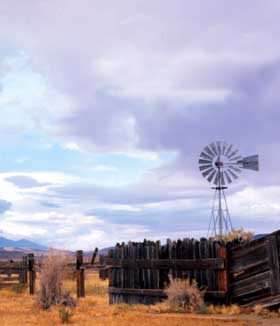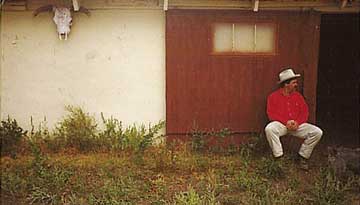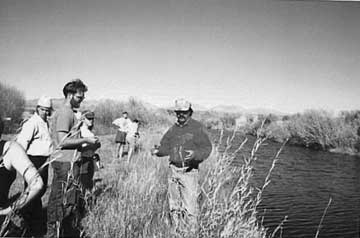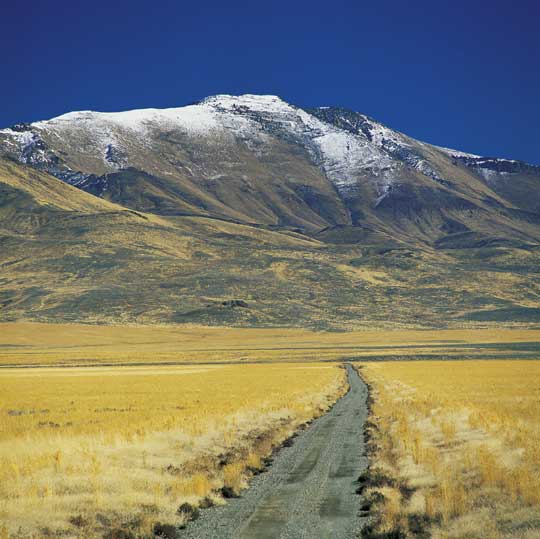|
|
|
| Subscriptions click here for 20% off! | E-Mail: info@rangemagazine.com |

 |
 |
 |
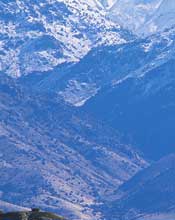 |
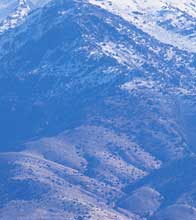 |
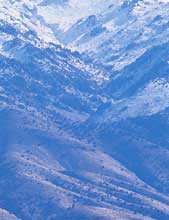 |
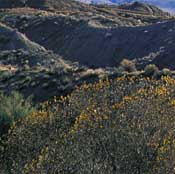 |
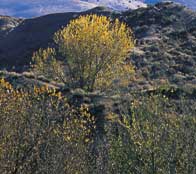 |
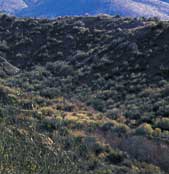 |
|
An old stone house sits comfortably among tall trees beside the thick willows that line the river bottom. Cattle and horses graze peacefully on the meadows beyond. And the hills rise gently toward the river’s headwaters in the Jarbidge Mountains. Preston Wright grew up here. He left the family ranch to go to Stanford University. But doubts about the future of ranching brought him back. “I came back because I didn’t think this life out here would last in the modern world,” Wright says. “And it may not.” He hesitates and adds, “But I forget that I used to think that.” Wright forgets because more than two decades after coming home and feeling that the ranching way of life might be on its last legs, things are looking better. At least for ranching culture, if not for the cattle business, which has its ups and downs. The annual Cowboy Poetry Gathering in nearby Elko, Nev., is one sign of a resurgence in appreciation for the culture and arts of ranching. The gathering has become a resounding success, bringing close to 10,000 people to the northeastern corner of Nevada in the dead of winter each year to celebrate the cowboy way. But it is not just the preservation of the culture that helps Wright forget that he once worried that ranching might not last. There has also been a renaissance in creative thinking about the future of ranching. The poetry gathering has sponsored workshops bringing together people from around the West to talk about securing the place of ranching, and ranching families, on the land. The discussions have ranged from holistic resource management to finding common ground between ranchers and environmentalists in their love of the land. Wright and his brother John have brought some of those ideas home to the Marys River Ranch. The Lahontan cutthroat trout, an endangered species that thrives in the Marys River, is a sign of that. And so are the sage grouse that make their yearly rounds in the sagebrush-covered hills surrounding the ranch. The Wrights are working with scientists and the federal land management agencies to restore the natural role of fire on the ranch’s private and public lands. A Typical Ranching Family? It is tempting to say that the Wrights are not your run-of-the-range ranching family. But in a culture that values iconoclastic individuals, it would not be saying much. There is no typical ranching family. Preston Wright is the straight-talking upcoming president of the Nevada Cattlemen’s Association. So he stands in for ranchers in general. His brother John is an active member of the Northeastern Nevada Stewardship Group, which has brought together ranchers, government agencies, scientists, environmentalists, and interested citizens in a search for agreement on how to manage the public lands, which are key to the survival of ranching. And it is in that process of being involved, as leaders and collaborators within the ranching industry and the wider community, that the Wrights, like dozens of other ranching families around the West, have found the best hope
for the future of ranching. These divergent interests are now converging in a growing consensus around an idea that ranchers have long known in their hearts: that working ranches are some of the last best places in the West. In addition to producing such key pieces of the culture of the American West as cowboy poetry and rodeo, ranches are key pieces of the ecological puzzle of the West. And the best way to keep them intact is by keeping ranching on the land. The Ecology of Ranching For many years, an angry debate has raged in the West. Essentially, ever since the great cattle drives of the Old West, ranching has been suspected of chewing up western ecosystems. In recent years, there have been calls for eliminating grazing from public lands, where ranchers lease pastures from the government. But in a surprising twist in this age-old debate, many scientists are now saying cattle ranches are the last best hope for preserving many native species in the western U.S. In a recent flurry of studies published in peer-reviewed scientific journals such as BioScience, Conservation Biology, and Environmental Science & Policy, scientists have concluded that large, intact working cattle ranches are key puzzle pieces holding together an increasingly fragmented landscape. Over the years, many studies have found some damage from grazing in and around streams in the desert West. But few studies have compared the alternatives to ranching on the private lands that are the home bases, not only for ranchers, but for many other species as well. Now scientists are beginning to take a close look, as more and more ranches around the West are going out of business and being carved up into ranchettes. Dr. Richard Knight, a professor of wildlife biology at Colorado State University, recently compared 93 similar sites on ranches, in state wildlife refuges, and in subdivisions with densities of about one house per
40 acres, which is typical on newly subdivided ranches. He found ranches have as much or more diversity of birds, carnivores and plants as similar areas that are formally protected as state wildlife refuges. And ranches have fewer nonnative species, such as invasive weeds, than wildlife refuges, he found. But more importantly, working ranches provide better habitat for wildlife than ranches that are subdivided. Ranchettes have fewer native species and more invasive species than ranches or protected areas. These findings take on added significance in light of recent demographic trends that show the West is growing faster than any other region in the country. And much of that growth is taking place in rural areas. Land conversion from agriculture to other uses is taking place at an even faster rate than population growth. Adding to their importance, private ranch lands are often situated at lower elevations with richer soils and more water than surrounding public lands. In some cases, private ranch lands are actually more productive breeding grounds for songbird populations on the higher elevation public lands, says Dr. Andrew Hansen, an associate professor of ecology at Montana State University. When ranches are converted to ranchettes some species get squeezed between increasing development at lower elevations and higher elevation lands that are protected but are not productive breeding habitat. The Radical Center Of course, songbirds are not the only ones feeling the squeeze. Ranchers are too. But lately the position in between has become a little less lonely, as scientists and some environmentalists have begun to join the ranks of people recognizing the importance of ranches in the West. Bill McDonald, the executive director of the Malpai Borderlands Group in Arizona, one of the oldest and most successful collaborative groups in the West, once dubbed this the “radical center.” Now he says he is ready for it to stop being the radical center and just be the center. “The status quo means eventual bankruptcy,” says Jim Winder, a New Mexico rancher and cofounder of the Quivira Coalition, another collaborative group that works with ranchers throughout the Southwest. “It is in the best interest of ranchers to join with environmentalists to solve conflicts in ways which enhance both biodiversity and economic stability,” says Winder. “If we embrace change we will find that our enemies can be our friends and the threats will become opportunities which will keep the land in the family for another generation.” In other words, the threat of ranches being turned into ranchettes is creating opportunities for ranchers to make their case for more productive rangelands, which will be good for cattle and good for wildlife. But seeing this common ground does not automatically make working together easy, according to Lynn Sherrod, the executive director of the Colorado Cattlemen’s Agricultural Land Trust. “You have to have all the players at the table,” she said, “the strange bedfellows representing the full gamut of local attitudes and interests: hard-bitten, property-rights old-time ranchers; newly arrived folks bringing outlandish ideas with them; environmentalists, suspicious that there is a slash-and-burn agenda in someone’s back pocket; agency representatives, pleased to be among the invited; county commissioners; town representatives; and just plain community members. “It takes an incredible amount of intestinal fortitude to stay there and be active and not leave the table,” Sherrod admitted. “You stay there because it’s important to tell people what you are for, not what you’re against. That’s the basis for true collaboration.” A Coalition Forged in Fire In Nevada, the collaborative spirit has been forged in fire. Specifically, in rangeland wildfires, which are increasingly recognized as both the symptom and cause of a landscape scale transformation of the sagebrush grasslands that cattle and wildlife depend on. The number of acres burned by wildfire in the state has doubled each decade since the 1950s. In 1999, two million acres burned. Much of that burned land was invaded by cheatgrass, a fast-growing annual grass that thrives with frequent fires. Cheatgrass dominates over nine million acres of Nevada, and is a major contributor to conflagrations that have scorched millions of acres and cost millions of dollars over the last decade This wildfire of change is sweeping across the land on such a vast scale that no single landowner or agency can tackle it alone. So in Ely, Nev., a group called the Eastern Nevada Landscape Coalition came
together last year “to restore and maintain the biological and ecological health of the Great Basin landscape through collaborative efforts.” The coalition has 50 partners, including Big Horns Unlimited, the Fraternity of Desert Sheep, Rocky Mountain Elk Foundation, Red Rock Audubon Society, and The Nature Conservancy, in addition to local ranchers and the Bureau of Land Management. Betsy Macfarlan, the former executive director of the Nevada Cattlemen’s Association, says the group “realized that the Band-Aid approach, addressing resource issues individually instead of as a whole, is not working. The federal agencies would be more successful in their endeavors to tackle landscape-sized restoration projects on federal lands if they had the support of a broad-based coalition.” Macfarlan was so impressed with the effort that she went to work for the coalition. Their goal is to restore 10 million acres of woodlands, sagebrush communities, riparian areas and grasslands. With Support on High Fortunately, there seems to be increasing support in high places for such grass-roots efforts. Kathleen Clarke, the director of the BLM, visited Ely in March. “I think this is exactly the type of model that I’d like to see the BLM adopt,” she told the coalition. “I truly believe that conservation efforts in this country are going to work when you have such citizen-based stewardship.” Clarke’s endorsement echoed earlier statements by her boss, Interior Secretary Gale Norton. “Successful conservation is a partnership between the government and people,” Norton said last year,
while announcing a program to encourage such collaborative efforts. “The government’s role is to empower people to take conservation into their own hands.” The Bush administration has asked Congress for $100 million for a Cooperative Conservation Initiative. The money would be split between states and the Interior Department for community-based, cost-sharing conservation projects. Norton called the initiative an example of a “new environmentalism”—empowering citizens and landowners to take conservation into their own hands. The secretary said this was the fourth wave of the environmental movement in the United States. The first wave came when President Theodore Roosevelt set up the national wildlife refuge system, the Forest Service, and 18 parks and monuments, she said. The second wave came with Aldo Leopold’s land ethic of managing public lands and resources as a whole, rather than for separate uses. Rachel Carson’s “Silent Spring” set off the third wave, leading to laws to protect the environment, but also to conflicts between the economy and environment. The new fourth wave of environmentalism focuses on incentives rather than punishment, said Norton, and it will be driven by “citizen conservationists” who emerge from the fray of previous battles to find grassroots solutions to environmental problems. There is a growing groundswell of support for such a fourth wave of environmentalism. In a recent survey conducted by the University of Nevada, 80 percent of residents in rural northeastern Nevada said they preferred a collaborative citizens’ participation or grassroots approach over debating these conflicts in the courts. And 64 percent said they or someone they know would be willing to work with a citizen’s group to identify and discuss natural resource issues. The Rightness of People on the Land Doug Clarke, a planner with the U.S. Forest Service in Elko, says. “There are a lot of good ideas and a lot of good energy on what I think now is the buzzword, community-based stewardship planning. I think that’s what’s going to keep the ranching community alive: looking at new ways to work with the government, outside interests, ways of getting healthy rangelands, and keeping working landscapes. Keeping the cowboy on the land, keeping ranching going in a sustainable way.” On the Marys River Ranch, Preston Wright says trying something new might be the only way to ensure that the ranching way of life he once thought might disappear will survive. “I think there are some people who feel we could go back to something we had before and that would be a good thing, and a fair thing,” he says. “I don’t think we could do that. I think the problems we have grew out of what we had before. And I think we need something new.” Jon Christensen is the author of “Nevada,” a book of essays celebrating the Silver State with photographs by Deon Reynolds (e-mail: d@deonreynolds.com ; www.deonreynolds.com>)Christensen has written for many of the state’s newspapers, as well as The New York Times, High Country News, and other newspapers and magazines. He also edits the online magazine GreatBasinNews.com, and produces “Nevada Variations,” a monthly feature on each of the state’s 17 counties, on Nevada Public Radio. He was awarded a Knight Journalism Fellowship at Stanford University for the 2002-2003 academic year, where he will focus on evaluating environmental conservation projects. |
|||||||||||||||||||
|
Winter 2003 Contents To Subscribe: Please click here or call 1-800-RANGE-4-U for a special web price Copyright © 1998-2005 RANGE magazine For problems or questions regarding this site, please contact Dolphin Enterprises. last page update: 03.29.05 |
|||

